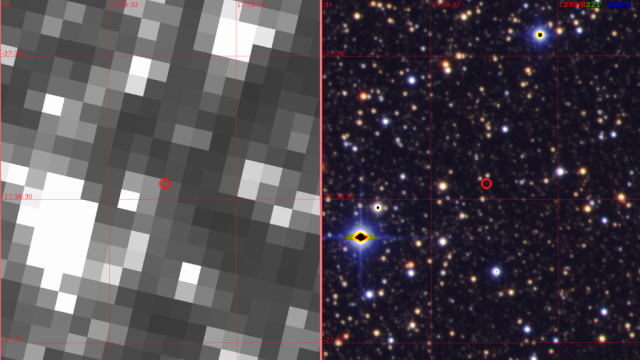An exoplanet with distinctly Jupiter-like characteristics has been discovered in old data gathered by NASA’s Kepler space telescope. Remarkably, Kepler made the observation using gravitational microlensing, in what is a first for a space-based observatory.
The new research is set to be published in Monthly Notices of the Royal Astronomical Society, and it describes K2-2016-BLG-0005Lb, an extrasolar planet with roughly the same mass as Jupiter and orbiting at a position comparable to Jupiter’s distance from our Sun. Data gathered by Kepler in 2016 was key to the detection. A preprint of the study is available at the arXiv.
“This discovery was made using a space telescope that was not designed for microlensing observations and, in many ways, is highly sub-optimal for such science,” the scientists, led by PhD student David Specht from the University of Manchester, wrote in the paper. “Nonetheless, it has yielded a direct planet-mass measurement of high precision, largely thanks to uninterrupted high observing cadence that is facilitated by observing from space.”
K2-2016-BLG-0005Lb is “the first bound microlensing exoplanet to be discovered from space-based data,” the scientists say. Indeed, Kepler managed to spot over 2,700 confirmed exoplanets during its illustrious nine-year career (the mission ended in 2018), but this marks the first time that Kepler, or any space-based telescope for that matter, managed to spot an extrasolar planet through a microlensing event.
Predicted by Albert Einstein, gravitational microlensing is a kind of cosmic magnifying glass that allows astronomers to see exaggerated views of celestial objects that would otherwise be obscured by foreground objects, such as stars. Heavy objects cause light to bend over vast distances. This allows astronomers to see the light from a background star from our vantage point, as the light curves around the foreground object.
“Planets magnify starlight only whilst they are almost perfectly lined up with a background star,” Eamonn Kerins, a co-author of the study and principal investigator for the Science and Technology Facilities Council, wrote to me in an email. “Roughly only one in 100 million stars in our galaxy have their light visibly distorted by the gravitational field of planets. And when the distortions happen, they are very brief, lasting a few hours to maybe a day.”
Kerins said these sorts of signals are very difficult to detect, as astronomers need to survey the brightness of many millions of stars every few months, sometimes for years. They then have to parse through vast amounts of data in hopes of finding the signals. Kepler, which relied on the transit method to spot exoplanets (in which the periodic dimming of stars is indicative of planets passing in front of them), wasn’t really built for this.
“The main problem with Kepler is that its camera has big pixels that give us a kind of Minecraft view of the inner galaxy. All the stars look really blocky, and there are many of them in each pixel,” Kerins explained. “The key was to model very accurately how Kepler’s pixels respond in very crowded star fields. Most of the stars in the field don’t vary, so we can inspect Kepler’s camera behaviour with those stars to construct the clearest possible signal from the lensed star that is varying.” To which he added: “It was tough!”
The astronomers were looking at Kepler data from 2016, specifically data from Campaign 9 of the Kepler K2 mission. A new search algorithm flagged five candidate microlensing signals from the dataset (as revealed in research from 2021), one of which — spotted near the galactic bulge — was found to be a “clear” microlensing event, according to the new study.
It just so happens that five — yes five — ground-based surveys were scanning the same location in space at the same time, namely the Optical Gravitational Lensing Experiment (OGLE-IV), the Canada–France–Hawaii Telescope (CFHT), Microlensing Observations in Astrophysics (MOA-2), the Korean Microlensing Telescope Network (KMTNet), and the United Kingdom InfraRed Telescope (UKIRT). The data from these observatories was used to corroborate the Kepler data and further characterise the Jupiter-like planet. These campaigns were looking at the right spot at the right time, but “none of the ground-based surveys flagged K2-2016-BLG-0005 in advance” of the 2021 study, the scientists write.
The newly spotted exoplanet is 17,000 light-years from Earth. It’s practically got the same mass as Jupiter and a similar orbit in terms of distance to its host star. This planet is “one of the closest cousins to Jupiter that has so far been found by any method,” said Kerins. “It’s also almost twice as far from us as the next furthest of the thousands of planets found by Kepler,” he said, adding that “by using this new method, we’ve been able to massively extend Kepler’s reach.”
Kepler is no longer around, but NASA’s upcoming Nancy Grace Roman Space Telescope, scheduled to launch later this decade, is specifically being built to find planets using microlensing. Kerins is hopeful that the Roman telescope will reveal the planetary architectures of other star systems and the abundance of potentially habitable worlds in the Milky Way, among other things. “It’s going to be a great ride,” he said.
